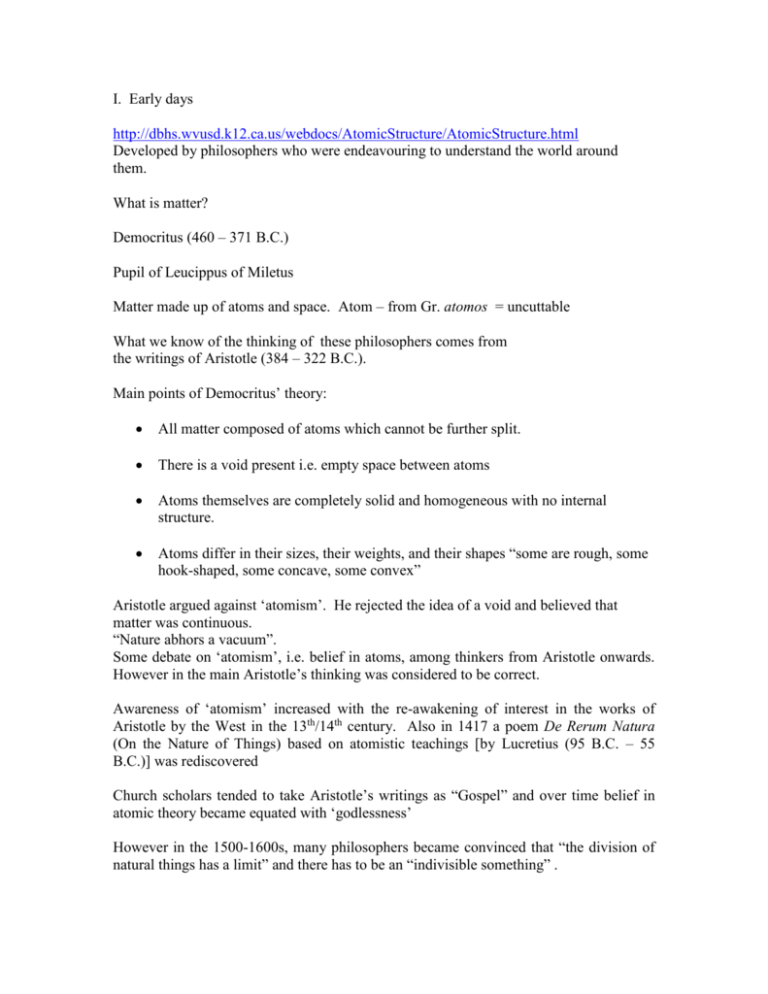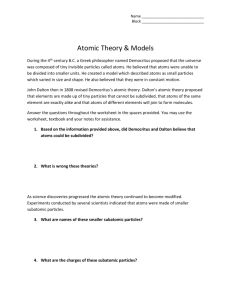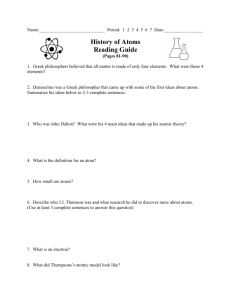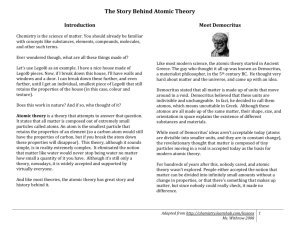Notes - Chemistry
advertisement

I. Early days http://dbhs.wvusd.k12.ca.us/webdocs/AtomicStructure/AtomicStructure.html Developed by philosophers who were endeavouring to understand the world around them. What is matter? Democritus (460 – 371 B.C.) Pupil of Leucippus of Miletus Matter made up of atoms and space. Atom – from Gr. atomos = uncuttable What we know of the thinking of these philosophers comes from the writings of Aristotle (384 – 322 B.C.). Main points of Democritus’ theory: All matter composed of atoms which cannot be further split. There is a void present i.e. empty space between atoms Atoms themselves are completely solid and homogeneous with no internal structure. Atoms differ in their sizes, their weights, and their shapes “some are rough, some hook-shaped, some concave, some convex” Aristotle argued against ‘atomism’. He rejected the idea of a void and believed that matter was continuous. “Nature abhors a vacuum”. Some debate on ‘atomism’, i.e. belief in atoms, among thinkers from Aristotle onwards. However in the main Aristotle’s thinking was considered to be correct. Awareness of ‘atomism’ increased with the re-awakening of interest in the works of Aristotle by the West in the 13th/14th century. Also in 1417 a poem De Rerum Natura (On the Nature of Things) based on atomistic teachings [by Lucretius (95 B.C. – 55 B.C.)] was rediscovered Church scholars tended to take Aristotle’s writings as “Gospel” and over time belief in atomic theory became equated with ‘godlessness’ However in the 1500-1600s, many philosophers became convinced that “the division of natural things has a limit” and there has to be an “indivisible something” . A dangerous position at that time as it was anti- Aristotle and in 1624 a law was passed in Paris that anyone holding or teaching a view opposed to Aristotle was liable to be put to death! However, one opponent of Aristotle’s thinking was the French philosopher/theologian, Pierre Gassendi, (1592 – 1655), who had friends in high places and so could expound his theories in safety. He agreed in the existence of atoms as the smallest indivisible part of matter, and managed to remove the ‘godlessness’ of the theory by proposing that atoms were created by God. Helped atomism to gain more widespread acceptance. [Another idea that he had was that atoms could ‘bond’ together to form groups or moleculae; the ‘bonds’ were formed by physical interactions e.g. hook-and-eye, antlers linking together, rather than the attractive forces we know nowadays] II. Dalton and the origin of modern atomic theory John Dalton (1766 – 1844) was a school-teacher from Manchester with an enquiring mind and a gift for deducing plausible theories from experimental observations. "Having been in my progress so often misled by taking for granted the results of others, I have determined to write as little as possible but what I can attest by my own experience” One of his pupils was James Joule, of the energy unit Joule. Like many scientists of that time, Dalton’s interests were extremely varied including mathematics, meteorology, as well as chemistry. He also developed a theory (later proved incorrect) to explain colour-blindness, from which both he and his brother Jonathan suffered. He asked that his eyes be examined after his death to test his theory – they are now in the Museum of Science and Industry, Manchester! Web-site: John Dalton, the man and his legacy: the bicentenary of his Atomic Theory, M.F. Lappert and J.N. Murrell, Dalton Transactions, 2003, 3811 - 3820 http://www.rsc.org/publishing/journals/DT/article.asp?doi=b307622a (Journal is the Inorganic Chemistry journal of the Royal Society of Chemistry; this is called Dalton Transactions in honour of Dalton) The significance of Dalton’s work on Atomic Theory is that his belief in atoms was founded on experimental evidence. Prior to Dalton, atomism was predominantly a philosophical concept rather than a scientific theory. The theory was developed from his measurements of atomic weights which he presented in 1803 merely as a supplement to his main lecture on absorption of gases by water. There are a number of conflicting accounts of how his thought-processes led him from this work to formulating the five postulates of his atomic theory listed here. One account suggests that his observation that different gases had different solubilities in water led him to speculate that the reasons for this behaviour lay in the different weights of the gases and the number of ‘ultimate particles’ of each. The idea that ‘ultimate particles’ were at the root of the differences convinced him of the reality of atoms. His postulates: 1. All matter is made up of atoms. These are indivisible and indestructible (aside: one of his pupils wrote that “atoms are wooden blocks invented by Mr. Dalton”) 2. Atoms of the same element are identical, both in mass and chemical properties; atoms of different elements have different masses and different chemical properties. 3. When a compound* is decomposed, the recovered atoms are unchanged and can re-combine to form the same or new compounds. 4. Atoms of different elements combine in simple whole number ratios to form compounds *The expression that Dalton uses for compound is “compound atoms” Some of Dalton’s ideas were later shown to be erroneous. For example, we now know that atoms are neither indivisible nor indestructible. However his theory provided an explanation for two ‘laws’ formulated previously from experimental observations. (a) The Law of Conservation of Mass (Lavoisier, in Traite Elementaire de Chimie, 1789) “The total mass of the products of a chemical reaction is the same as the total mass of the reactants” i.e. matter is neither created nor destroyed in a chemical reaction [Lavoisier’s principal occupation was a tax-collector in pre-revolutionary France; he was executed because of this in the aftermath of the French Revolution in 1794 – a plea for clemency was rejected since as the President of the tribunal said: “The republic has no need of chemists and savants”] This law is ‘covered’ by Dalton’s third postulate above i.e. atoms retain their identities in reactions and reactions simply involve rearrangements of atoms to form new compounds. (b) The Law of constant composition (Proust, Madrid, 1797) “The elemental composition of a pure compound is always the same regardless of its source” (Bursten, 9th Edition) or put another way “Reacting elements combine in a constant ratio in a given compound” The fourth postulate above provides an ‘atomic’ explanation of this law. But Dalton took this further. From his experiments with nitrogen and oxygen, he concluded that there were 3 possible oxides depending on the relative ratios of the two elements. Hence he deduced his law of multiple proportions. “If two elements combine to form more than one compound, then the amounts of one element that combine with a fixed amount of the other will differ by factors that are the ratios of small whole numbers” The explanation of this, Dalton concluded, was that elements must be made up of indivisible and independent particles (atoms) that combine in simple predictable ratios. In other words, if you have say one atom of a particular element, then it can only combine with 1 or 2 or 3 or 4 atoms of the other element, not with e.g. 0.5 of an atom. [“If two elements A and B combine to form more than one compound, then the masses of B that can combine with a given mass of A are in the ratio of small whole numbers”, Bursten 9th ed.] Thus he concluded that the concept of atomism was the only way of explaining observed experimental data. Apart from the error in his assumption of the indivisibility of atoms, there was another short-coming to Dalton’s theory which became evident within his own lifetime. But first a look at how Dalton represented chemical reactions – by inventing the first system of chemical symbols (adapted from Dickerson, Gray, Haight, Chemical Principles, 3rd edition, 1979) (Comment on the first three reactions.) These symbols were quickly superseded by the simpler system devised by the Swedish chemist Jons Berzelius of using one or two initials taken from the element’s name. However Dalton still must be credited with being the ‘inventor’ of the shorthand way in which we write chemical reactions today. III. Problems with Dalton’s theory Dalton made one crucial error in his theory the result of which was that his atomic theory was at odds with experimental data from both Gay-Lussac and from Avogadro. This discrepancy delayed the general acceptance of atomic theory by as much as fifty years. In developing an understanding of relative ratios of elements in compounds, Dalton adopted the approach that the simplest explanation is the best (unless there are very good reasons to think otherwise!). He proposed that when two elements combine to form just one type of compound, then the combining ratio is 1:1. i.e. A + B gives AB in a 1:1 ratio if there is only one possible compound formed from the combination of A and B. If there are two types of compound formed, then their formulae are AB, and either A2B or AB2 The reaction of oxygen with hydrogen gave just one product water (hydrogen peroxide was only discovered in 1818) Based on Dalton’s rule, water should be formulated as HO. Similarly the formula for ammonia should be HN. Clearly incorrect to our eyes! Also seemingly in disagreement with the law of combining volumes which the French chemist Joseph Louis Gay-Lussac (http://www.woodrow.org/teachers/chemistry/institutes/1992/Gay-Lussac.html) deduced from his experiments on gases and presented on the last day of the year of 1808 at a scientific meeting in Paris. “At a given temperature and pressure the volumes of gases that react with one another are in the ratios of small whole numbers” (Bursten, 9th ed.) Among his results were the following: 2 volumes of hydrogen gas reacts with 1 volume of oxygen gas to give water. 3 volumes of hydrogen react with 1 volume of nitrogen gas to give ammonia. To us, those observations are consistent with the formulae of H2O and H3N. However for Gay-Lussac they were simply observations – he didn’t actually believe in the law of constant composition and did not therefore see the wider significance of his own work Dalton interpreted Gay-Lussac’s data as implying that equal volumes of gases do not have the same number of molecules. So for example you can assume that there are twice as many molecules of oxygen in one volume of that gas than there are molecules of hydrogen in one volume of that gas, thus leading to the product HO rather than H2O. In 1811, the Italian chemist Amadeo Avogadro proposed an alternative theory to explain Gay-Lussac’s results. He put forward the hypothesis that equal volumes of gases at the same temperature and pressure had the same number of molecules. If this is true, then a further assumption has to be made i.e. the gases hydrogen, oxygen and nitrogen are composed of two-atom molecules rather than being isolated atoms as Dalton had assumed. We now know that Avogadro was correct, but at the time his ideas were controversial. To many of the early 19th century scientific community, his assumptions seemed rather shaky, equal numbers in equal volumes and the existence of diatomic molecules. At the time, chemical bonding was considered to be mainly a question of electronic attraction/repulsion and it was difficult to understand how two identical atoms could possibly be attracted. Furthermore even if they were attracted, why stop at diatomics? Why not H3, H4, H5…? As the 19th century progressed, the flaw in Dalton’s “simplest explanation” rule became more and more obvious. As chemists worked to deduce formulae for different compounds using experimental data on the relative masses of the constituent elements and trying to fit these data to the simplest possible formula, it became clear that this just wasn’t working out. Between 1850 and 1860, over 13 different formulae were ascribed to acetic acid (vinegar). (Dickerson) (Chemical principles / Richard E. Dickerson, Harry B. Gray, Gilbert P. Haight.) This confusion led some like the French organic chemist, Jean Dumas (1800 – 1884) to write: “If I were in charge, I would efface the word atom from science” (Dickerson) By 1860, there was so much controversy in the field of chemistry that a German chemist Friedrich August Kekule (1829-1896) had the idea of holding the first ever International Chemistry Congress in Karlsruhe in Germany. (In 1865 Kekule proposed the ring structure for benzene) He invited all European chemists to attend in order to attempt to resolve disputes on issues like the definition of “atom” and “molecule”, chemical nomenclature, and, very importantly the determination of atomic weights. For an account of the proceedings of the meeting see: http://webserver.lemoyne.edu/faculty/giunta/karlsruhe.html Among the chemists attending was a (relatively) young Italian, Stanislao Cannizzaro (1826-1910). He proposed a method for determining atomic weights based on Avogadro’s hypothesis first proposed before Cannizzaro was born i.e. that equal volumes of gases at the same temperature and pressure had the same number of molecules Details of his method are in Dickerson, Gray and Haight, p. 244. The most important feature of his method is that it works! It gave correct atomic weights for the elements known at that time. Putting these together with experimental data on percentage composition of a particular substance led to an unambiguous chemical formula. The reproducibility of the results using Cannizzarro’s method, helped atomic theory to gain wider acceptance, though for many years there were still eminent scientists who had their doubts. “The atomic hypothesis provides a convenient form of speech, which successfully describes many of the facts in a metaphysical manner. But the handy way in which the atomic hypothesis lends itself to the representation of the characteristic features of a chemical change falls short of constituting a proof that atoms have any real existence” Alexander Smith, Professor of Chemistry, University of Chicago, 1910 Another sceptic was the physicist, Ernst Mach (1838 – 1916) who believed until his death that scientists should look at facts, not hypothetical entities such as atoms. It was only with experiments which demonstrated the existence of particles such as the electron and proton that atomic theory gained universal acceptance. It was also these experiments which showed quite clearly that the Dalton view of the atom as a hard indivisible sphere was incorrect. In addition, Dalton’s model does not explain why elements combine in a particular ratio e.g. why is there 3 hydrogens to 1 nitrogen in ammonia? Why 2 hydrogens to 1 oxygen in water? A new more complex model is needed. http://www.pbs.org/wgbh/aso/databank/entries/dp32ne.html “people and discoveries” James Chadwick 1891 – 1974 http://chemcases.com/2003version/nuclear/nc-01.htm Nuclear chemistry discovery of the neutron. IV. Discovery of the electron Discovered in 1897 by J.J. Thomson (1856-1940). http://www.chemheritage.org/classroom/chemach/atomic/thomson.html (About JJ Thomson) http://www.aip.org/history/electron/ (Discovery of the electron) To understand how he came to his discovery, need to consider earlier work by physicists investigating the nature of electricity. It was observed that when a partially evacuated tube (containing a low pressure of a gas) was fitted with electrodes and an electric current was applied, then a glow was observed in the tube. William Crookes showed that this glow was due to “rays”, generated in the presence of the current. These rays came from the cathode, hence were called cathode rays. Using cathodes made of different metals gave rise to the same type of rays suggesting the existence of these negative rays in all matter. Crookes concluded that these “rays” were made up of small particles from his paddle wheel experiment. (Paddle wheel on rail in the chamber, on turning on the current, it began to rotate and move down the tube from the cathode to the anode) Thomson – similar experimental set-up. Discovered that the rays were attracted towards positive charged plate – see Figure, and concluded that the particles were negatively charged. Called these particles – electrons, using the word proposed by George Stoney to the smallest amount of electrical charge. Note: the Thomson (and modern) meaning of electron refers to the particle, not its charge. Using an external magnetic field he discovered that the rays were also deflected in a magnetic field. From these experiments, he was able to determine the ratio of the cathode ray’s charge to its mass. (1.76 x 108 Coulombs/ gram) (For more details see, http://www.aip.org/history/electron) In 1906, he was awarded the Nobel Prize in Physics for his work on discovering the electron and confirming its particle nature; (interestingly in 1937, his son, George Paget Thomson (1892-1975) shared in the Nobel Prize for Physics for "for experimental discovery of the diffraction of electrons by crystals" which implied that electrons had wave properties) Most significantly: By comparing the mass-to-charge ratio of the cathode ray particle with that of the lightest charged particle in solution, Thomson concluded that the mass of the particle was less than 1/1000 that of the hydrogen atom! This suggested to him that atoms were in fact divisible into smaller particles – a revolutionary idea for that time. Indeed some thought that he was joking when he first suggested this idea. Aside: A modern-day descendant of Thomson’s apparatus is the mass spectrometer (p. 45 Bursten 9th Ed). It measures mass per unit charge of the substance to be analysed and hence leads to accurate atomic and molecular masses. This instrument operates as follows: Sample converted to positive ions by collisions with a stream of high energy electrons on entering the spectrometer. Charged sample is accelerated using applied voltage Ions then passed into an evacuated tube and through a magnetic field. Magnetic field causes ions to be deflected by different amounts depending on their mass. Ions with the same mass-to-charge ratio hit the detector at the same spot Back to Thomson et al. He determined the charge to mass ratio of the electron, but could not determine either property independently. In 1909, an American physicist Robert Millikan (1868-1953) carried out his famous “oil-drop” experiment which allowed him to determine the charge on the electron and hence using Thomson’s data, the mass. Basis of experiment: X-rays knock electrons from gas molecules in air, and these electrons stick to the oil droplets falling through the positive plate. Thus the oil droplets become negative. By turning off the field and measuring the rate at which the droplet falls, its mass can be determined. By adjusting the strength of the electric field, the drops can be made to fall at different rates and the overall charge on the droplets measured. Found that the charge was always a multiple of a minimum charge, -1.602 x 10-19 Coulombs. Concluded that this was the charge on the electron. (Within 1% of the modern value!) Was able to calculate the mass of the electron since now the charge and the charge-tomass ratio were known. 19 x10 C 1 . 60 9.10 x10 g Mass x / g 1.76 10 C 28 8 Very very light so why are atoms so heavy (relatively!)? And since these are charged particles and atoms are neutral, where are the positive charges? Answer: In the “plum pudding”!!!Thomson suggested that atoms consist of electrons embedded in a sphere of positively charged matter (like fruit embedded in a plum pudding). No experimental evidence, just a way of explaining the presence of negative particles in a neutral atom. V Discovery of the nucleus In 1911, Ernest Rutherford (1871-1937) [a New Zealand-born physicist and former student of Thomson’s] published the results of experiments which showed that Thomson’s model was incorrect. Rutherford had already (1908) received the Nobel Prize in Chemistry for his work on radioactivity – certain elements are not stable and spontaneously ‘decay’ emitting radiation or particles. One of the particles emitted is the alpha particle, which we now know to be a He nucleus (2 protons and 2 neutrons), but in Rutherford’s time all he knew was that it had a positive charge. His experiment involved bombarding a piece of gold foil with these alpha particles. Assuming Thomson’s model where the only particles present are electrons, he expected that the particles would just go straight through the gold foil and hit the detector without being deflected off-course as the electrons would be too small to have any effect. For most of the particles that was what happened. However, after a couple of days one of his co-workers Geiger (of the Geiger counter) came to him very excited and told him that a few of the alpha particles had actually ‘bounced back’. Rutherford recalled afterwards that it was like having fired a shell at a piece of tissue paper and having it coming back and hitting you. The only way that this could be explained was if there was something small, dense and positive in the gold atoms which was repelling the alpha particles. Since so few particles were deflected, this ‘something’ could not occupy much space in the atoms. From calculations on the angle of the deflection, and the mass, charge and velocity of the bombarding particles Rutherford concluded that an atom is mainly space occupied by electrons, but in the centre of that space there is a tiny region which he called the nucleus. Within the nucleus is the positive charge and the mass of the atom. He proposed that the positive charge was made up of positive particles which he later called protons. He still couldn’t explain the mass of the atom – only in 1932 with the discovery of the neutron by James Chadwick was that part of the story completed. So we have a positively charged nucleus which is very small (nucleus to atom size ratio is that of pea to football stadium!) Surrounding the nucleus are electrons which are moving… Problem – if electrons (charges) are moving, then according to classical physics they should radiate energy, and hence eventually collapse into the nucleus i.e. atoms are not stable!! Solved in 1912 by the Danish physicist Niels Bohr (1885 – 1962) who got his doctorate the same month that Rutherford published his paper, and then came to work for Thomson for 6 months before joining Rutherford’s group in 1912. (http://www.pa.msu.edu/~brock/d0_homepage/physics-posted/surprises-bohr.html - why Bohr left Thomson and went to work for Rutherford http://www.pbs.org/wgbh/aso/databank/entries/dp13at.html More on Bohr’s life) Niels Bohr came to England to work for Thomson because he was intrigued by the ‘plum pudding’ model. He felt that it was incorrect and wanted to develop a better model. However he was a shy man and found Thomson difficult to work with as the latter tended to walk off mid-sentence and not have a lot of time for discussion with his group. At the Christmas party of Thomson’s group at the end of 1911, Bohr met Rutherford who was a very out-going jovial character and much more to the young Dane’s liking. So early the following year Bohr moved up to Manchester to join Rutherford’s team. Bohr was familiar with the quantum theory of Max Planck who had proposed in 1900 that energy rather than being continuous in fact came in distinct particles or quanta (quantum being the smallest packet of energy that existed). Bohr suggested that electrons were also quantised in the atom i.e. that they existed only in certain fixed orbits or energy levels. When they gained or lost energy they jumped from one level to the other never being in an in-between state. This theory fitted the observed data on the emission spectra of Hydrogen (CM1000, RPB). Equally important was Bohr’s proposal that electrons moving in these orbits did not radiate energy, therefore there was no energy loss and no danger of the atom collapsing in on itself. Bohr’s theory developed as an attempt to explain the observed data – it did not have a firm theoretical basis and later it was shown that the image of electrons circling a central nucleus in specified orbits was over-simplified. Wave-particle duality – quantum mechanics – atomic orbitals…..






